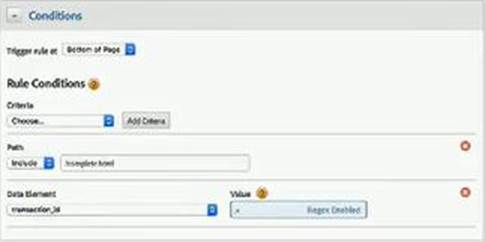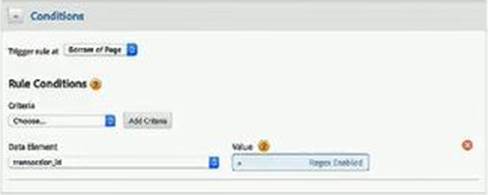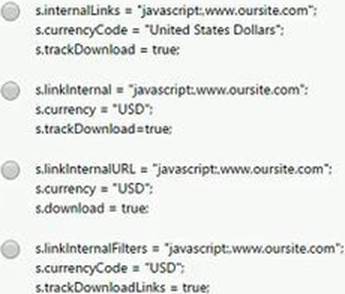Adobe 9A0-411 Adobe Analytics Developer ACE Online Training
Adobe 9A0-411 Online Training
The questions for 9A0-411 were last updated at Apr 10,2025.
- Exam Code: 9A0-411
- Exam Name: Adobe Analytics Developer ACE
- Certification Provider: Adobe
- Latest update: Apr 10,2025
A site analyst is using Adobe Analytics reports to review the progress of a recently launched paid search campaign. The paid search keywords report in Adobe Analytics has no data for the current month.
How should this problem be fixed?
- A . Configure the "Paid Search Detection" rules to include all campaign URL parameters.
- B . Request access to the "Paid Search Detection" report in the admin console.
- C . Create a "search keyword classification" on the campaign variable.
- D . Enable campaign tracking reporting in the UI.
A developer creates a Page load rule in Adobe Dynamic Tag Management (DTM) that should capture a visitor’s transaction ID when a purchase is completed on the site at "http://www.oursite.com/complete.html."
The condition of this page load rule in DTM is as shown:

Assume the "Path" condition of this rule was not present, as seen below

What would be the outcome in the situation?
- A . The rule would no longer function because all page load rules need a path condition.
- B . The page load rule could incorrectly fire anywhere that the "transaction_id’ data element is present.
- C . The rule would NOT function because page load rules require two conditions.
- D . There would be no difference in the firing of this page load rule.
A developer creates a Page load rule in Adobe Dynamic Tag Management (DTM) that should capture a visitor’s transaction ID when a purchase is completed on the site at "http://www.oursite.com/complete.html."
The condition of this page load rule in DTM is as shown:

Assume the "Path" condition of this rule was not present, as seen below

What would be the outcome in the situation?
- A . The rule would no longer function because all page load rules need a path condition.
- B . The page load rule could incorrectly fire anywhere that the "transaction_id’ data element is present.
- C . The rule would NOT function because page load rules require two conditions.
- D . There would be no difference in the firing of this page load rule.
A developer creates a Page load rule in Adobe Dynamic Tag Management (DTM) that should capture a visitor’s transaction ID when a purchase is completed on the site at "http://www.oursite.com/complete.html."
The condition of this page load rule in DTM is as shown:

Assume the "Path" condition of this rule was not present, as seen below

What would be the outcome in the situation?
- A . The rule would no longer function because all page load rules need a path condition.
- B . The page load rule could incorrectly fire anywhere that the "transaction_id’ data element is present.
- C . The rule would NOT function because page load rules require two conditions.
- D . There would be no difference in the firing of this page load rule.
A developer creates a Page load rule in Adobe Dynamic Tag Management (DTM) that should capture a visitor’s transaction ID when a purchase is completed on the site at "http://www.oursite.com/complete.html."
The condition of this page load rule in DTM is as shown:

Assume the "Path" condition of this rule was not present, as seen below

What would be the outcome in the situation?
- A . The rule would no longer function because all page load rules need a path condition.
- B . The page load rule could incorrectly fire anywhere that the "transaction_id’ data element is present.
- C . The rule would NOT function because page load rules require two conditions.
- D . There would be no difference in the firing of this page load rule.
Clicks on download links are tracked
Which selection of code meets the requirements?

- A . Option A
- B . Option B
- C . Option C
- D . Option D
An Adobe Analytic Developer needs to set s.campaign with the query string value whenever a query string of ?cid=[[value]] is present in the URL. The client does NOT want s.campaign to track duplicate values during the same visit to avoid tracking duplicate clickthroughs.
The developer has developed the following code in AppMeasurement:
s.campaign = s.Util.getQueryParam(‘cid’);
Which line of code should be used to meet the rest of the tracking requirement?
- A . s.campaign = s.UtiLuniqueVal;
- B . s.campaign = s.getValOnce(‘cid’)
- C . s. campaign = s.UtilcookieRead(‘s_.campaign’);
- D . s.campaign = s. getValOnce(s.campaign, ‘s_campaign’);
A developer needs to trigger an Adobe Analytics s.tl() onClick on all buttons across all pages in one of the site dircetories. The developer creates a direct call rule to set the s.tl() for the buttons.
For example:
www.acme.com/pageswithbuttons/index.html
www.acme.com/pageswithbuttons/anotherpagewithbuttons.html
Dynamic Tag Management (DTM) is currently embedded on all site pages. There is no data layer on the site. The site’s IT team is too busy to help the developer.
Why is a direct call rule in inappropriate solution for the problem?
- A . s_code’s doPlugins is appropriate for this type of tracking with in DTM
- B . Direct call rules only have one condition (a string to call the rule)
- C . Direct call rules have many conditions but NOT a pathname condition
- D . A Page Load rule can fire a s.tl()
Latest 9A0-411 Dumps Valid Version with 62 Q&As
Latest And Valid Q&A | Instant Download | Once Fail, Full Refund

